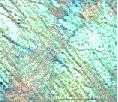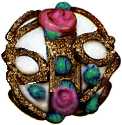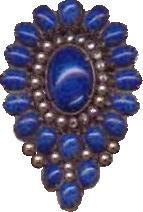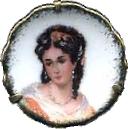
 |
| Our subscribers' grade-level estimate for this page: 3rd - 5th |
Illustrated Dictionary of Jewelry |
 |
||||||
| A | B | C | D | E | F | G | H | I | J | K | L | M | N | O | P | Q | R | S | T | U | V | W | X | Y | Z |
LAB RUBY (SAPPHIRE) A lab ruby (or sapphire) is a synthetic (laboratory-made) stone. It has the same composition, hardness, and specific gravity as natural rubies (or sapphires) but is much less expensive than a natural stone (since they are relatively inexpensive to create in the laboratory as comared to mining gemstones). These lab-produced stones can be legally referred to as "real" stones [as opposed to "natural" (mined) stones]. |
 LABRADORITE Labradorite (a variety of plagioclase feldspar) is a fairly abundant grayish mineral that has brilliant flashes of color (usually green, blue or red) after it is polished (called labradorescence). The crystals are transparent to translucent. There is a darker variety of labradorite (called "black moonstone") which has bluish inclusions. Labradorite is usually cut with a flat surface in order to highlight the flashes of color. Labradorite was originally found along the coast of Labrador about 1805; it is also found in Newfoundland, other parts of Canada, Ukraine, the Ural mountains, and the USA. Labradorite has a hardness of 6 to 6.5 and a specific gravity of 2.70. Finnish labradorite is also known as spectrolite. |
LAGUNA Laguna is a mark used on costume jewelry made by Royal Craftsmen Inc. of New York City. The company was founded in 1944. Laguna pieces are mostly from low to average quality, and often use plastic beads, glass beads, or simulated pearls. |
 LAMPWORKED GLASS Lampworked glass (also called torchwork) is formed from glass canes and tubes that are shaped by hand over a flame (oil lamps and bellows were originally used, hence the name lampworking). Lampworked glass beads are made in a wide variety of colors, shapes, and designs, including millefiori, rose-like overlay beads (pictured above), aventurine glass, and many others. Lampworking was invented in the 1700's in Murano, Italy. |
LAPIDARY A lapidary is someone who cuts and polishes gemstones. |
 LAPIS LAZULI Lapis lazuli is a rich blue opaque, semi-precious stone that has been used in jewelry since ancien times. Ground-up lapis lazuli was once used as a pigment for oil paintings. Lapis lazuli is often dyed to deepen and improve its color. Lapis has a hardness of 5.5; it chips and scratches easily. It has a specific gravity of 2.4 to 2.9. Water can dull its sheen. Lapis lazuli contains the minerals calcite (which decreases its value), pyrite (which can increase its value), and sodalite. Swiss lapis is not Lapis lazuli at all; it is dyed jasper. Denim lapis is relatively pale, low-grade, inexpensive lapis from Chile; it is the color of denim cloth because of calcite inclusions (which whiten the color and lower the value). |
LARIMAR Larimar is a form of pectolite (with copper) found only in a single place in the Dominican Republic. It is an opaque sky blue stone with white streaks. There are often some red to brown impurities. Larimar is usually shaped and polished (but not faceted). Larimar has a hardness of 4.5 - 6.0 and a specific gravity of 2.7 to 2.9. Larimar is not enhanced. Larimar was named for Larisa (the daughter of Miguel Mendez, a geologist who helped reintroduce this stone) and mar (the Spanish word for sea). |
LATHE A lathe is a machine that turns metal, wood, etc. The material to be turned is held horizontally on the machine and rotated very quickly while the jeweler applies a sharp cutting tool to the material, removing excess material, shaping the article. Rings are sometimes turned on a lathe, but most jewelers do not use lathes. |
LAVA Lava from the volcano Vesuvius near Pompeii in Italy has been used to make jewelry, especially cameos. Lava jewelry was popular in the nineteenth century. |
LAVALIER A lavalier is a pendant with a dangling stone that hangs from a necklace. Lavaliers were named for the infamous Duchess Louise de La Valliere (1644-1710), a French woman who was a mistress of the French king Louis XIV (and was involved in many intrigues at court). |
LEAD CRYSTAL Lead crystal is high-quality glass containing at least 10% lead oxide. Glass containing at least 24% lead oxide is called lead crystal. Glass containing at least 30% lead oxide is called full lead crystal. Lead added to the melt produces very clear glass resembling rock crystal. The process of making lead crystal was discovered by the English glassmaker George Ravenscroft in 1676. Crystal is colored by adding various metallic oxides to the melt. When cut and polished, crystal becomes quite brilliant. |
LEAF Metallic leaf is paper-thin sheets of metals. For example, gold, silver, platinum, and copper are rolled or pounded into metallic leaf which can be applied to surfaces. |
 LEAF The plant leaf is a common motif in jewelry. The leaf pin pictured above was made by the Trifari jewelry company. |
LEATHER CORD JEWELRY Jewelry strung on a thin leather cord has become popular recently. Pendants, beads, shell, feathers, and/or sharks teeth are strung on leather to make interesting necklaces and bracelets. |
LENTIL CUT A lentil cut stone is a cabochon cut in which the upper and lower portions of the stone are identical. |
LIBERTY & COMPANY Liberty & Co. was a British jewelry manufacturer that combined the Arts and Crafts style and the Art Nouveau style in their mass-produced pieces. Liberty & Co. was founded in 1975 by Arthur Lazenby Liberty (1843-17). Archibald Knox (1864-1933) was the chief designer for Liberty and Co. |
 LIMOGES Limoges is a French company that produces fine china. The miniature plate pin pictured above is made of porcelain that is accented with gold. |
LINDE STAR SAPPHIRE Linde star sapphire ("Linde stars") are synthetic star sapphires that were first made by the Linde Air Products Company in 1947 (they also developed star rubies that year). The Linde company later became a division of Union Carbide. Star sapphires are sapphires that have a six-sided asterism. |
 LISNER Lisner was a costume jewelry manufacturer. D. Lisner and Company of New York, New York, USA, first produced jewelry from 1935 (they first used the mark Lisner in 1938) in the 1970's. They made necklaces, bracelets, earrings, and pins aimed at the medium- to lower-priced costume jewelry market (although many Lisner pieces are very high quality and beautifully designed). Lisner pieces often have colorful rhinestones (including aurora borealis stones) and molded plastic stones. The Lisner pin above has delicate enamel work, an aurora borealis stone, and imitation pearls. |
L/N The marks L/N and L/N25 "Nemo Gold Seal Quality" belonged to the Brier Manufacturing Company (L/N perhaps standing for "Little Nemo"). This company produced brooches, necklaces, bracelets, dress clips, earrings, tiaras, hair clips, etc., often featuring colorful rhinestones in gold-plated pot metal. Nemo was another mark of the Brier Manufacturing Company, a costume jewelry company located in Providence, Rhode Island, USA. The Nemo mark was first used in January, 1913. |
LOBSTER CLAW CLASP A lobster claw clasp is a jewelry fastener that resembles the claw of a lobster. A tiny spring keeps the arm of this clasp closed. It is used to attach two other rings or links of a necklace or bracelet. |
LOCKET A locket is a pendant that can open up. Lockets can hold photos, hair, a charm, or other small, precious object. |
LONDON BLUE TOPAZ London blue topaz (Aluminum silicate fluoride hydroxide) is the darkest blue variety of topaz. Most blue topaz is silver topaz that has been irradiated and heat treated, but some stones are blue naturally. London blue topaz is found in Brazil, U.S.A., Sri Lanka, Myanmar (Burma), Russia, Australia (including Tasmania), Pakistan, Mexico, Japan, and Africa. Topaz has a hardness of 8 and a specific gravity of 3.5-3.6. |
LORGNETTES Lorgnettes are glasses (or opera glasses, which are small binoculars) that are mounted on a handle. This type of glasses was used a long time ago. |
LOST WAX CASTING Lost wax casting is a process of casting metal in which the original model is sculpted in wax. The wax is then enclosed in clay and the wax is melted out, making a hollow mold. The mold is then filled with molten metal. The clay is broken off and the cast metal remains. This method of casting has been used for at least 4,000 years. |
LOZENGE A lozenge has a diamond shape. A lozenge cut stone is a step-cut gem with a diamond shape. |
 LUCITE Lucite is a clear (transparent), strong plastic (a thermoset acrylic resin) that was patented by the DuPont company in 1941. Lucite has a specific gravity of 1.19. Although it is clear, it can be colored. The bangle above is made of transparent confetti lucite. |
LUSTER A stone's luster is its sparkle or sheen - the way it relects light. The luster depends on the nature of the stone's surface reflectivity. Some types of luster include: adamantine (also called brilliant or diamondlike, like a faceted diamond), earthy (with little reflectivity- also called dull, like shale or clay), greasy (like nepheline or apatite), metallic (also known as splendent, like pyrite or marcasite), resinous (like amber), pearly (with an iridescent reflectivity, like pearls or mica), pitchy (tarry minerals that are radioactive, like uraninite), silky (with a fibrous structure, like some tiger's eye or satin spar), vitreous (also known as glassy, like olivine, transparent quartz, or obsidian), and waxy (like halite or turquoise). A pearl's luster is derived from its nacre. |
Illustrated Dictionary of Jewelry |
 |
||||||
| A | B | C | D | E | F | G | H | I | J | K | L | M | N | O | P | Q | R | S | T | U | V | W | X | Y | Z |
Enchanted Learning®
Over 35,000 Web Pages
Sample Pages for Prospective Subscribers, or click below
|
Overview of Site What's New Enchanted Learning Home Monthly Activity Calendar Books to Print Site Index K-3 Crafts K-3 Themes Little Explorers Picture dictionary PreK/K Activities Rebus Rhymes Stories Writing Cloze Activities Essay Topics Newspaper Writing Activities Parts of Speech Fiction The Test of Time
|
Biology Animal Printouts Biology Label Printouts Biomes Birds Butterflies Dinosaurs Food Chain Human Anatomy Mammals Plants Rainforests Sharks Whales Physical Sciences: K-12 Astronomy The Earth Geology Hurricanes Landforms Oceans Tsunami Volcano |
Languages Dutch French German Italian Japanese (Romaji) Portuguese Spanish Swedish Geography/History Explorers Flags Geography Inventors US History Other Topics Art and Artists Calendars College Finder Crafts Graphic Organizers Label Me! Printouts Math Music Word Wheels |
Click to read our Privacy Policy
| Search the Enchanted Learning website for: |